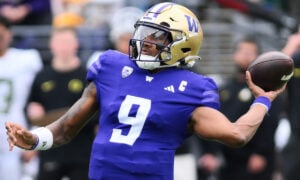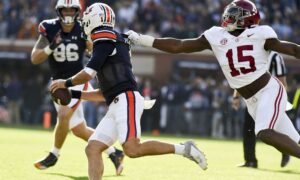Big Ten Prospects: Carlos Hyde and C.J. Fiedorowicz
Last week, I highlighted two of the best wide receivers in the Big Ten, Allen Robinson and Jared Abbrederis. This week, I’ll cover two more prospects from my favorite conference. One of which everybody knows about, and another that may be flying under the radar. Let’s get right to it.
Carlos Hyde, RB Ohio State
 If somebody were to ask me what I thought about Carlos Hyde a year ago, I wouldn’t have given a very favorable opinion of him. Although he rushed for 970 yards (5.2 YPC) and 16 touchdowns as a junior, he looked slow and lazy, and reminded me so much of former Iowa tailback Shonn Greene that I hardly considered him to be an NFL prospect at all.
If somebody were to ask me what I thought about Carlos Hyde a year ago, I wouldn’t have given a very favorable opinion of him. Although he rushed for 970 yards (5.2 YPC) and 16 touchdowns as a junior, he looked slow and lazy, and reminded me so much of former Iowa tailback Shonn Greene that I hardly considered him to be an NFL prospect at all.
Over the off-season, Hyde didn’t do much to change my opinion of him. He was arrested due to an incident with a woman in a bar. Although he was never prosecuted in the case, Ohio State head coach Urban Meyer suspended Hyde for the first three games of the 2013 season.
After serving his suspension, Hyde was used sparingly in the Buckeyes’ 76-0 beat-down of Florida A&M. He handled the ball only six times in the game. Then Ohio State entered Big Ten play with a battle against Wisconsin. He carried the ball 17 times for 85 yards and didn’t look overly impressive throughout the game. Just like his play as a junior, he only got what was blocked and didn’t look a guy that liked contact. He was stopped twice on short yardage opportunities. Once on fourth and one and the other at the goal line.
After that game, I was confident in my outlook of Hyde. Starting a week later on a rain-soaked field at Northwestern, that opinion started to change ever so slightly.
He was a bruising runner that night against the Wildcats, always lowering his head to get extra yardage. Most impressively, he was quick and decisive. I’d never seen him attack the line of scrimmage like he did on that soggy field. He carried the ball 26 times for 168 yards and three touchdowns while adding a career high four receptions for 38 yards. It was the best overall game I’d seen Hyde play and the first of nine straight 100-yard games he had to finish his career in Columbus.
On the season, he tallied 208 carries for 1,521 yards (7.3 YPC) and 15 touchdowns and added 16 receptions for 147 yards and three more scores in 11 games. Rather impressive numbers when you consider that he did it while facing some of the toughest competition the country has to offer against the run. The Buckeyes faced five teams ranked in the top-36 in the nation in rushing defense over the final ten games of the season and two of those teams finished in the top-five (Michigan St. and Wisconsin).
Over that stretch, Hyde showed the powering style I liked so much in the game against Northwestern relatively often, but reverted to his old ways as a soft ball carrier far too frequently for my liking, hesitating in the backfield and going down on first contact way too much.
I’m extremely conflicted when trying to grasp Hyde’s potential as an NFL runner. Even though he’s listed at 6 feet tall and 240 pounds, he doesn’t use his size to his advantage and isn’t the attacking, downhill runner you’d like to see when looking at a tailback of his stature.
In Hyde’s defense, most of his carries came out of the read-option, which doesn’t give the running back an opportunity to get his momentum going towards the line of scrimmage. He was often asked to carry the ball while going east and west and that didn’t always allow him to get a head of steam and run behind his pads.
What may be the most maddening part of Hyde’s game may be the inconsistency he’d often demonstrate, particularly with his vision. It wouldn’t be uncommon for him to show hesitation when trying to choose a running lane, ricochet off a blocker and be taken down by an arm tackle on one play. Then, on the very next snap he’d display brilliant anticipation, quickly shift his feet and blast through a hole, falling forward with excellent leg drive for a first down.
With all that said, Hyde improved dramatically between his junior and senior seasons. He displayed excellent agility and a quick burst inside the tackles, something he didn’t demonstrate nearly as often in 2012. He has extremely quick feet which allows him to jump-cut into a hole with ease. For his size, he’s nimble. He showed the ability to cut sharply, making defenders miss in the open field.
The most impressive demonstration I saw of his open field ability came against Michigan on a third quarter carry. He took a read-option handoff off left tackle where the safety had him lined up. He stepped towards the middle of the field and put his right foot in the ground, suddenly bursting down the left sideline for 30-plus yards. The tackler didn’t even touch him.
Many have questioned his blocking and how that will affect his ability to get on the field at the next level but I see him as an above average pass blocker and he has the size to get even better in the NFL. Many have also been critical of his pass catching ability but I didn’t see him drop a pass or make a mistake in the passing game in the games I watched. In my opinion, he simply wasn’t asked to contribute enough out of the backfield to judge his prowess in that area.
Overall, Hyde is physically gifted. He has the body of, and has shown at times that he can be a bruising, attacking tailback, yet he has the athleticism and footwork of a back much smaller than he is. If he continues to improve, as he did as a senior, and becomes more consistent in his play, he has the potential to become an effective every down ball carrier at the next level.
Playing in the zone-read system with Braxton Miller over the last couple seasons hasn’t been the ideal fit for Hyde. He belongs in a power running offense where he’s primarily used as a downhill runner inside the tackles.
If he ends up in such a situation and showcases himself well over the next couple months, dynasty owners will be moving him up their draft boards, possibly as high as the middle of the first round. Personally, I see his fantasy upside as an RB2. And that’s just not worth a first round pick in rookie drafts.
2013 games watched: Wisconsin, @ Northwestern, Iowa, Penn State, @ Michigan, Michigan State (Big Ten Title Game), Clemson (Orange Bowl)
C.J. Fiedorowicz, TE Iowa
If you’re looking for the next Jimmy Graham or Rob Gronkowski, keep looking. C.J. Fiedorowicz isn’t in the mold of the downfield threats we’ve become accustomed to seeing over the last handful of seasons. That’s not to say he can’t be an effective NFL tight end and contribute to fantasy teams, however.
I became a fan of Fiedorowicz during his junior season at Iowa in a game at Michigan towards the end of the year. He caught eight passes that afternoon for 99 yards and dominated as a run blocker. He ran excellent routes and used his big frame very well to keep defenders away from the football and make space to make the catch. Mostly he was used on short out routes and crossing patterns that day, but his good hands and dominating blocking were quite eye popping.
After the 2012 season ended, Fiedorowicz considered entering the 2013 NFL draft. Coming off a 45 reception season where he racked up 433 yards but only one touchdown, he decided instead to return to Iowa for his senior year.
With the lack of playmakers in the Iowa offense entering the season, I thought Fiedorowicz would be a featured part of the Hawkeyes’ offensive game plan on a weekly basis but that was hardly the case. When the season kicked off, the Iowa coaching staff seemed hell bent on using him as an extension of the offensive line. Because he’s such a dominant blocker, they didn’t ask him to use his receiving skills very often during the first five games of the 2013 season. Over that span, he caught only eight passes for 77 yards and one touchdown.
Then he started getting opportunities in the red zone. He caught touchdowns in five of the next seven games. Overall, he tallied only 30 receptions for 299 yards as a senior, but he did haul in six touchdowns.
Dynasty owners shouldn’t be fooled by the relatively meager numbers Fiedorowicz put up in 2013. He may as well have put on a jersey with a number in the sixties for much of the season as he was used as a blocking tight end far too often. When he was used in the passing game it was in third down situations, which he excelled in, and around the goal line where he converted nearly every time I saw him called upon.
When you see Fiedorowicz’s physical attributes, it’s easy to see why Kirk Ferentz and the rest of the Iowa coaching staff saw him as an asset in the running game and even as a pass blocker. He’s listed at 6’7, 265 pounds and is incredibly physical at the line of scrimmage. He’s a mauling blocker at the point of attack and is relentless down the field in the running game, an attribute that NFL coaches will love and is sure to help him get on the field early in his career.
Because of his size, most wouldn’t expect Fiedorowicz to show much athleticism, but that’s not necessarily the case. Nobody will ever accuse him of having great burst, but he has long strides and moves very fluently after the catch and when in space. Make no mistake about it, he’s not going to make many defenders miss in the open field but he has incredible balance for a player of his size and the power to go through tackles.
While in college, Fiedorowicz was primarily used on short to intermediate routes. He was often asked to run five to ten-yard outs and curl routes. Due to his lack a quickness, he didn’t get a lot of separation but he used jukes and head fakes well at the top of his routes to get open. Once the ball was in the air, he displayed an innate ability to shield off defenders with his large body to make the catch. Most importantly, he has soft hands and a large catch radius, which will help him as a red zone threat on Sundays.
Fiedorowicz is one of my favorite players in the Big Ten. I have very little doubt he’ll be a starting tight end in the NFL. Due to his blocking abilities and limitations stretching a defense, I could see him being a better NFL tight end than fantasy tight end, but he should absolutely be on dynasty owners’ radar going into rookie drafts, especially those in deep or tight end premium leagues. Overall I think he has the upside equal to that of Heath Miller and that would be an excellent return late in rookie drafts.
2013 games watched: @ Michigan State, @ Ohio State, Wisconsin, Michigan, LSU (Outback Bowl)
Next week, we’ll take a look at Michigan wide receiver Jeremy Gallon as well as a pair of Wisconsin tight ends, Jacob Pedersen and Brian Wozniak.
Follow me on Twitter: @dmeylor22
- League Tycoon: Dynasty Salary Cap Fantasy Football - December 15, 2023
- Final Dynasty Rookie Report Card: Wide Receivers, Part Two - March 22, 2023
- 2023 NFL Scouting Combine: Offensive Player Dynasty Review - March 10, 2023


































































